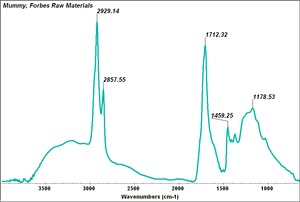Mummy
Jump to navigation
Jump to search
Description
A dark brown, bituminous pigment prepared in the 16th and 17th centuries by grinding fragments of Egyptian mummies. These mummies had been embalmed with Asphaltum (also called bitumen), but over time the asphaltum had lost many of its volatile compounds. The ground residue apparently produced a pigment that was more durable and less susceptible to cracking than fresh asphaltum. In the 19th c., mummy brown was used as a transparent brown pigment for oil painting and for oil glazes. Some substitutes, such as Vandyke brown and bituminous earth pigments, were also sold under the name of mummy.
Synonyms and Related Terms
Egyptian brown; Natural Brown 11; mummy brown; Mumienbraun (Deut.); momie (Fr.);
Resources and Citations
- R.White "Brown and Black Organic Glazes, Pigments and Paints" National Gallery Technical Bulletin, 10:58-71, 1986. ° Georgiana Languri, Molecular studies of Asphalt, Mummy and Kassel earth pigments, MOLART report 2004, available through Archetype Publications, London.
- R. J. Gettens, G.L. Stout, Painting Materials, A Short Encyclopaedia, Dover Publications, New York, 1966
- Helmut Schweppe, Schweppe color collection index and information book
- Ralph Mayer, A Dictionary of Art Terms and Techniques, Harper and Row Publishers, New York, 1969 (also 1945 printing)
- Susan E. Schur, Conservation Terminology: A review of Past & Current Nomenclature of Materials, Technology and Conservation, Spring (p.34-39); Summer (p.35-38); Fall (p.25-36), 1985
- R.D. Harley, Artists' Pigments c. 1600-1835, Butterworth Scientific, London, 1982
- Thomas B. Brill, Light Its Interaction with Art and Antiquities, Plenum Press, New York City, 1980
- Art and Architecture Thesaurus Online, http://www.getty.edu/research/tools/vocabulary/aat/, J. Paul Getty Trust, Los Angeles, 2000
